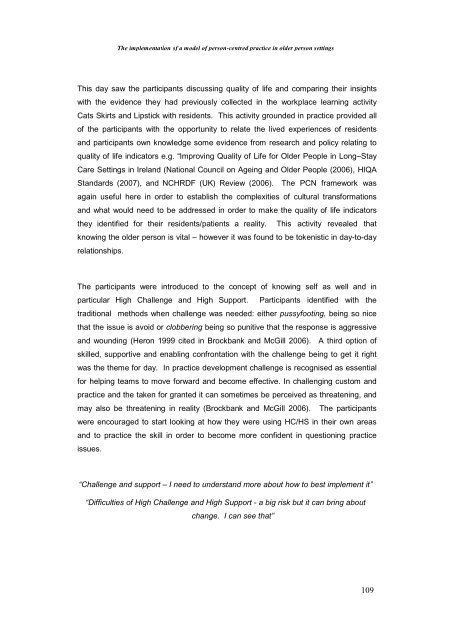The Implementation of a Model of Person-Centred Practice In Older ...
The Implementation of a Model of Person-Centred Practice In Older ...
The Implementation of a Model of Person-Centred Practice In Older ...
You also want an ePaper? Increase the reach of your titles
YUMPU automatically turns print PDFs into web optimized ePapers that Google loves.
<strong>The</strong> implementation <strong>of</strong> a model <strong>of</strong> person-centred practice in older person settings<br />
This day saw the participants discussing quality <strong>of</strong> life and comparing their insights<br />
with the evidence they had previously collected in the workplace learning activity<br />
Cats Skirts and Lipstick with residents. This activity grounded in practice provided all<br />
<strong>of</strong> the participants with the opportunity to relate the lived experiences <strong>of</strong> residents<br />
and participants own knowledge some evidence from research and policy relating to<br />
quality <strong>of</strong> life indicators e.g. “Improving Quality <strong>of</strong> Life for <strong>Older</strong> People in Long–Stay<br />
Care Settings in Ireland (National Council on Ageing and <strong>Older</strong> People (2006), HIQA<br />
Standards (2007), and NCHRDF (UK) Review (2006). <strong>The</strong> PCN framework was<br />
again useful here in order to establish the complexities <strong>of</strong> cultural transformations<br />
and what would need to be addressed in order to make the quality <strong>of</strong> life indicators<br />
they identified for their residents/patients a reality. This activity revealed that<br />
knowing the older person is vital – however it was found to be tokenistic in day-to-day<br />
relationships.<br />
<strong>The</strong> participants were introduced to the concept <strong>of</strong> knowing self as well and in<br />
particular High Challenge and High Support. Participants identified with the<br />
traditional methods when challenge was needed: either pussyfooting, being so nice<br />
that the issue is avoid or clobbering being so punitive that the response is aggressive<br />
and wounding (Heron 1999 cited in Brockbank and McGill 2006). A third option <strong>of</strong><br />
skilled, supportive and enabling confrontation with the challenge being to get it right<br />
was the theme for day. <strong>In</strong> practice development challenge is recognised as essential<br />
for helping teams to move forward and become effective. <strong>In</strong> challenging custom and<br />
practice and the taken for granted it can sometimes be perceived as threatening, and<br />
may also be threatening in reality (Brockbank and McGill 2006). <strong>The</strong> participants<br />
were encouraged to start looking at how they were using HC/HS in their own areas<br />
and to practice the skill in order to become more confident in questioning practice<br />
issues.<br />
“Challenge and support – I need to understand more about how to best implement it”<br />
“Difficulties <strong>of</strong> High Challenge and High Support - a big risk but it can bring about<br />
change. I can see that”<br />
109
















